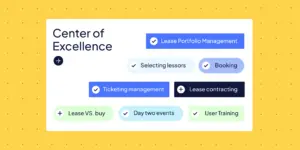
What leasing processes are best managed by a Center of Excellence (CoE)?
Bruce Conway | Senior Advisor – Solution Engineering @ Nakisa In the first blog in
Line of Business: HR Suite

Written by: Philip Hofton, Director of Business Development and Strategy at Nakisa
Read Time: 7 Min
Philip Hofton is the director of business development and strategy at Nakisa. For over 20 years, he has been helping organizations optimize their talent, manage post-merger processes, and integrate organizations accordingly to best practices on the market.
From our experience of collaboration with Fortune 1000 companies, we can tell that the value of any organizational integration resides in getting teams to collaborate very quickly right after merger and acquisition (M&A). Being a mix of financial and talent challenges, post-merger organizational integration often requires difficult trade-offs. For example, retaining key leaders and high salaries versus massive reductions in headcount.
In this blog, let’s see what organizational integration is and discuss the best practices and strategies after the merger and acquisition.
Organizational integration is a set of rules and processes that empower alignment among different departments and teams, as well as with internal and external business stakeholders. Organizational integration is about streamlining business processes, facilitating communication and collaboration, integrating technology, optimizing costs and engaging with all employees to pursue business goals and achieve operational excellence.
In this blog, we will speak about organizational integration that happens through mergers and acquisitions, when business leaders, HR professionals and external consultants integrate teams, build a new organizational structure and mobilize talent to set up the organization for long-term success.
During post-merger processes, actions must be taken quickly based on information that’s far from complete and teams often feel pressure to demonstrate synergies as soon as possible. To make the whole process of post-merger integration smoother, let’s explore key do’s and don’ts for organizational integration.
Don’t make it personal
The complex organizational journey should be based on company capabilities and goals, not on individuals. It should not be around somebody’s personal history or existing influence in their organizations. You don’t owe it to person A or person B to maintain their comfort level. You do owe it to stakeholders, including newly acquired talent, to create new organizational structure and the conditions for success based on performance.
This will inevitably lead to some difficult conversations. But do not let personal feelings influence your decisions. Focus on what is best for the company. On the other side, you may uncover hidden gems that you didn’t know existed through the traditional financial evaluation of the deal.
Don’t assume you can do it by yourself
Often, pre-deal evaluations are limited to financial costs and ROI, while the risks and opportunities from a talent perspective are underestimated. To understand them and bring maximum value out of the integration, reach out for help. There are partners who do this for a living and who can offer outside expertise, objectivity and sound recommendations. There is a lot going on as you build the business, and business continuity should be a priority through the transition. Be humble, be open to new ideas.
For large companies, it’s also crucial to leverage organizational design software. It centralizes all the HR data you have in isolated systems and enables you to see the role duplications and gaps in a post-merger organization via org charts. The software allows HR professionals and team managers to collaborate on various parts of the organizational structure, model its new version and track the key KPI metrics in advance.
Don’t ignore any feedback from leaders in the acquired organization
They know their people better than you will do even in a year. Rely on them as advisors on how to get the most out of the talent that built that organization. They also have talent development plans in place that are invaluable in preparing the future of the post-merger company.
Now let’s move on to the key dos for smooth organizational integration after a merger or acquisition.
Know what you are buying in terms of talent
Ask questions before you buy and evaluate the potential fit with the existing organization. People are by far the most important drivers of value in any acquisition. They represent assets that need to be understood across various dimensions:
Although this information may not be easy to obtain as you go through due diligence stages, there are many other sources to get a better sense of the culture and talent landscape. These sources can include personal networks, publicly available online sources, consulting and research firms.
At the very least, you should have an instrument to measure the factors that are predictive of talent success through the transaction. These are the same factors that need to be understood when we put in plan succession planning and retention programs.
Move quickly
Every moment counts to achieve the transaction’s benefits. There are three stages of post-merger organizational integration:
The problem is that too often organizations get stuck between co-habitation and integration stage. New organizations exist independently and autonomously while systems and operations start to merge. This is a tough time for key talent since they don’t feel as if they are part of the family and are concerned about their future in the combined organization. You also don’t want to waste your time while moving to optimization phase, since it will save your costs and maximize the efficiency of newly created organization.
My advice is to have a clear plan for integration from day one and move quickly between phases.
Dream
Take time to form a picture in your head of what the organization will look like in two or three years. What new capabilities? What will be the drivers of value? What will the workforce look like? What will be important to them as they build their careers inside the growing organization? The constraints and limitations will reveal themselves soon but it’s important to start with a target in mind and work backwards. There’s nothing wrong with shaping an idealistic view of talent and the organization of the future.
Business transformations can be complex and challenging events. As you embark on your integration journey, keep in mind that envisioning the future organization and its capabilities is crucial. By following key do’s and don’ts discussed in this guide, companies can increase their chances of success in post-merger organizational integration.
Remember, the true value of integration lies in bringing teams together, not being afraid of tough decisions, and creating a unified organization. We wish you good luck in achieving a seamless and prosperous integration that sets the stage for future growth and success.
A trusted partner of Fortune 1000 companies, Nakisa has 20+ years of experience in supporting large enterprises to go through organizational changes. Drafted for better collaboration between HR professionals, team managers, and executives, Nakisa HR Suite offers various features for organization visualization and modelling, advanced analytics and reporting, facilitating restructuring endeavors, streamlining headcount planning, precision in headcount budgeting, and offering profound insights into workforce forecasting. Ultimately, it serves as a cornerstone in driving an organization’s workforce planning efforts, ensuring alignment with overarching objectives—whether those encompass transformation, expansion, consolidation, or divestiture.
Easily connect Nakisa with ERPs via native bidirectional integrations (SAP HCM, SAP SFSF, Workday, and Oracle) and all other HR systems you’re using via RESTful APIs. We’re ready to plug into any system you’re using to empower your organizational structure from Day 1!

Bruce Conway | Senior Advisor – Solution Engineering @ Nakisa In the first blog in

Read our comprehensive guide on HR data quality: its dimensions, importance, and 5 steps to

This article will explore eight strategic questions you should consider before moving to a new